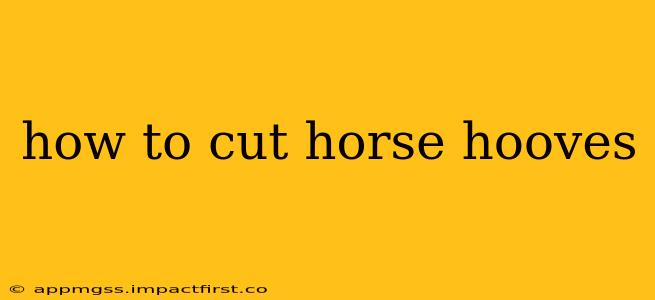Maintaining your horse's hoof health is crucial for their overall well-being and performance. Regular hoof trimming, also known as hoof care, prevents lameness, improves balance, and ensures comfortable movement. While some owners choose professional farriers, understanding the basics of hoof trimming can empower you to better care for your horse. This guide provides a comprehensive overview of the process, highlighting safety precautions and crucial considerations. Disclaimer: This guide provides general information. Professional farrier services are highly recommended, especially for beginners. Improper hoof trimming can cause serious injury to your horse.
What Tools Do I Need to Cut Horse Hooves?
Before you begin, ensure you have the correct tools. Improper tools can lead to uneven cuts and potential injury. Essential tools include:
- Nippers: These are used to remove excess hoof wall. Different sizes are available, depending on the horse's size and hoof thickness.
- Rasp: A rasp is used to smooth the hoof wall and sole after trimming.
- hoof knife: A hoof knife is used to clean out the frog and to remove loose material.
- Measuring tools: A hoof gauge or measuring tape can help ensure consistent trimming.
- Cleaning Brush: A brush to remove dirt and debris from the hoof before starting.
How Often Should I Trim My Horse's Hooves?
The frequency of hoof trimming varies depending on the horse's individual growth rate, activity level, and hoof type. Generally, horses need their hooves trimmed every 4-8 weeks. However, some horses may require more frequent attention. Observe your horse's hooves regularly and contact your farrier if you notice any significant changes or rapid growth.
How to Trim Horse Hooves: A Step-by-Step Guide
This section is for informational purposes only. Attempting to trim your horse's hooves without proper training is strongly discouraged. Incorrect trimming can lead to serious hoof problems and lameness.
Ideally, this process should be done by a professional farrier who is trained to assess the horse’s hoof and body conformation. However, this is a general overview of the process:
- Preparation: Ensure your horse is calm and properly restrained. A well-fitting halter and lead rope are essential. Clean the hooves thoroughly to remove dirt and debris.
- Assessment: Carefully examine the hoof, noting any abnormalities or areas of concern.
- Trimming the Hoof Wall: Use the nippers to remove excess hoof wall, maintaining the natural angle of the hoof. Work gradually, removing small amounts at a time.
- Smoothing the Hoof Wall: Use the rasp to smooth any rough edges or uneven areas on the hoof wall.
- Frog and Sole Care: Clean the frog and sole area, removing any loose debris or stones.
- Balancing the Hooves: Ensure that the hooves are balanced, allowing the horse to stand comfortably and evenly distribute its weight.
What are the Signs of Improperly Trimmed Hooves?
Recognizing signs of improperly trimmed hooves is vital for your horse's health. Look for:
- Lameness: If your horse is limping or exhibiting signs of discomfort, it could be due to improperly trimmed hooves.
- Uneven Hoof Wear: Uneven wear patterns can indicate imbalances in the hoof.
- Cracks or Chips in the Hoof Wall: These can result from incorrect trimming techniques.
- Changes in Gait: Noticeable changes in your horse's stride may signal a problem.
How Can I Tell if My Horse Needs a Farrier?
Regular farrier visits are essential for maintaining your horse's hoof health. However, knowing when you need one is crucial. Here are some signs that indicate it’s time to contact a farrier:
- Rapid hoof growth: If you notice excessive hoof growth between regular trimming, it’s time for professional help.
- Abnormal hoof wear: Uneven or excessive wear on the hoof can indicate underlying issues.
- Signs of lameness: Limping or altered gait can be a direct result of poor hoof health.
- Hoof cracks or other abnormalities: If you see any cracks, chips, or other abnormalities in your horse's hoof, a farrier should assess the situation.
What are the Different Types of Hoof Trims?
Different hoof trimming techniques exist, often tailored to the horse's individual needs and conformation. These variations might include adjustments for specific hoof shapes, hoof wall angles, or addressing particular hoof issues. A skilled farrier will select the most appropriate method for your horse.
How Much Does Hoof Trimming Cost?
The cost of hoof trimming varies depending on your location, the farrier's experience, and the horse's individual needs. It's advisable to contact local farriers for quotes and to establish an ongoing relationship with a trusted professional.
Remember, professional farriers possess the expertise and experience to provide safe and effective hoof care for your horse. While understanding the basics is helpful, always prioritize professional care to ensure your horse's well-being.
